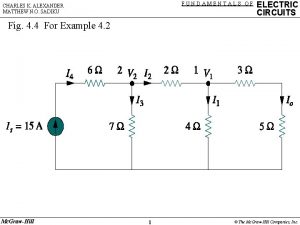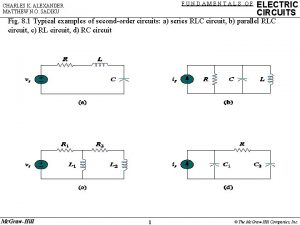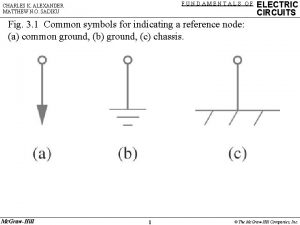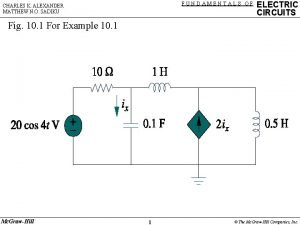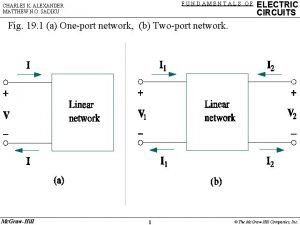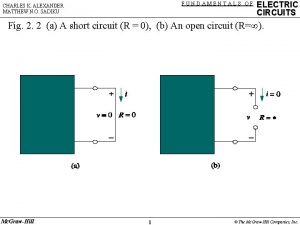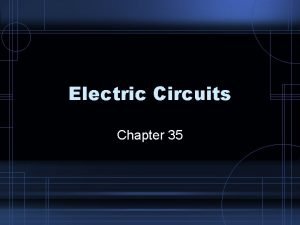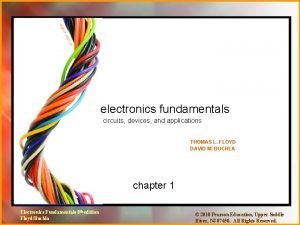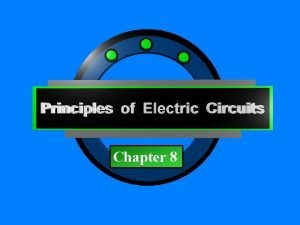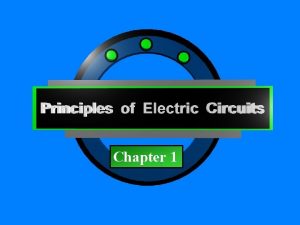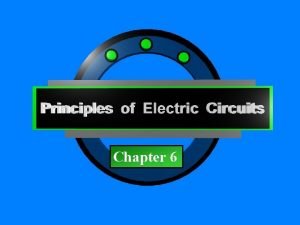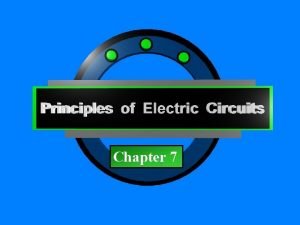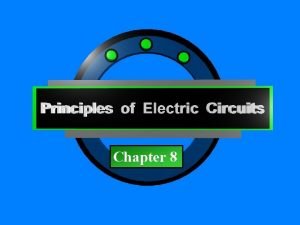Chapter 6 Electric Circuits Fundamentals Floyd Copyright 2007



























- Slides: 27

Chapter 6 Electric Circuits Fundamentals - Floyd © Copyright 2007 Prentice-Hall

Chapter 6 Summary Identifying series-parallel relationships Most practical circuits have combinations of series and parallel components. Components that are connected in series will share a common path. Components that are connected in parallel will be connected across the same two nodes. Electric Circuits Fundamentals - Floyd 1 2 © Copyright 2007 Prentice-Hall

Chapter 6 Summary Combination circuits Most practical circuits have various combinations of series and parallel components. You can frequently simplify analysis by combining series and parallel components. An important analysis method is to form an equivalent circuit. An equivalent circuit is one that has characteristics that are electrically the same as another circuit but is generally simpler. Electric Circuits Fundamentals - Floyd © Copyright 2007 Prentice-Hall

Chapter 6 Summary Equivalent circuits For example: is equivalent to There are no electrical measurements that can distinguish the boxes. Electric Circuits Fundamentals - Floyd © Copyright 2007 Prentice-Hall

Chapter 6 Summary Equivalent circuits Another example: is equivalent to There are no electrical measurements that can distinguish the boxes. Electric Circuits Fundamentals - Floyd © Copyright 2007 Prentice-Hall

Chapter 6 Summary is equivalent to There are no electrical measurements that can distinguish between the three boxes. Electric Circuits Fundamentals - Floyd © Copyright 2007 Prentice-Hall

Chapter 6 Summary Kirchhoff’s voltage law and Kirchhoff’s current law can be applied to any circuit, including combination circuits. For example, applying KVL, the path shown will have a sum of 0 V. Electric Circuits Fundamentals - Floyd So will this path! © Copyright 2007 Prentice-Hall

Chapter 6 Summary Kirchoff’s current law can also be applied to the same circuit. What are the readings for node A? Electric Circuits Fundamentals - Floyd © Copyright 2007 Prentice-Hall

Chapter 6 Summary Combination circuits Tabulating current, resistance, voltage and power is a useful way to summarize parameters. Solve for the unknown quantities in the circuit shown. I 1= 21. 6 m. A I 2= 12. 7 m. A I 3= 8. 9 m. A IT= 21. 6 m. A R 1= 270 W R 2= 330 W R 3= 470 W RT= 464 W Electric Circuits Fundamentals - Floyd V 1= 5. 82 V P 1= 126 m. W V 2= 4. 18 V P 2= 53. 1 m. W V 3= 4. 18 V P 3= 37. 2 m. W VS= 10 V PT= 216 m. W © Copyright 2007 Prentice-Hall

Chapter 6 Summary Kirchhoff’s laws can be applied as a check on the answer. Notice that the current in R 1 is equal to the sum of the branch currents in R 2 and R 3. The sum of the voltages around the outside loop is zero. I 1= 21. 6 m. A I 2= 12. 7 m. A I 3= 8. 9 m. A IT= 21. 6 m. A R 1= 270 W R 2= 330 W R 3= 470 W RT= 464 W Electric Circuits Fundamentals - Floyd V 1= 5. 82 V P 1= 126 m. W V 2= 4. 18 V P 2= 53. 1 m. W V 3= 4. 18 V P 3= 37. 2 m. W VS= 10 V PT= 216 m. W © Copyright 2007 Prentice-Hall

Chapter 6 Summary Loaded voltage divider The voltage-divider equation was developed for a series circuit. Recall that the output voltage is given by + A A voltage-divider with a resistive load is a combinational circuit and the voltage divider is said to be loaded. The loading reduces the total resistance from node A to ground. Electric Circuits Fundamentals - Floyd © Copyright 2007 Prentice-Hall

Chapter 6 Summary Loaded voltage divider A What is the voltage across R 3? Form an equivalent series circuit by combining R 2 and R 3; then apply the voltage-divider formula to the equivalent circuit: 8. 10 V Electric Circuits Fundamentals - Floyd © Copyright 2007 Prentice-Hall

Chapter 6 Summary Loading effect of a voltmeter 4. 04 10 VV Assume VS = 10 V, but the 4. 04 V meter reads only 4. 04 V when it is across either R 1 or R 2. Can you explain what is happening? All measurements affect the quantity being measured. A voltmeter has internal resistance, which can change the resistance of the circuit under test. In this case, a 1 MW internal resistance of the meter accounts for the readings. Electric Circuits Fundamentals - Floyd © Copyright 2007 Prentice-Hall

Chapter 6 Summary Wheatstone bridge The Wheatstone bridge consists of a dc voltage source and four resistive arms forming two voltage dividers. The output is taken between the dividers. Frequently, one of the bridge resistors is adjustable. When the bridge is balanced, the output voltage is zero, and the products of resistances in the opposite diagonal arms are equal. Electric Circuits Fundamentals - Floyd © Copyright 2007 Prentice-Hall

Chapter 6 Summary Wheatstone bridge Example: What is the value of R 2 if the bridge is balanced? 384 W 12 V 470 W 330 W 270 W Electric Circuits Fundamentals - Floyd © Copyright 2007 Prentice-Hall

Chapter 6 Summary Thevenin’s theorem states that any two-terminal, resistive circuit can be replaced with a simple equivalent circuit when viewed from two output terminals. The equivalent circuit is: Electric Circuits Fundamentals - Floyd © Copyright 2007 Prentice-Hall

Chapter 6 Summary Thevenin’s theorem VTH is defined as the open circuit voltage between the two output terminals of a circuit. RTH is defined as the total resistance appearing between the two output terminals when all sources have been replaced by their internal resistances. Electric Circuits Fundamentals - Floyd © Copyright 2007 Prentice-Hall

Chapter 6 Summary Thevenin’s theorem What is the Thevenin voltage for the circuit? 8. 76 V What is the Thevenin resistance for the circuit? 7. 30 k. W Output terminals Remember, the load resistor has no affect on the Thevenin parameters. Electric Circuits Fundamentals - Floyd © Copyright 2007 Prentice-Hall

Chapter 6 Summary Thevenin’s theorem is useful for solving the Wheatstone bridge. One way to Thevenize the bridge is to create two Thevenin circuits - from A to ground and from B to ground. The resistance between point A and ground is R 1||R 3 and the resistance from B to ground is R 2||R 4. The voltage on each side of the bridge is found using the voltage divider rule. Electric Circuits Fundamentals - Floyd © Copyright 2007 Prentice-Hall

Chapter 6 Summary Thevenin’s theorem For the bridge shown, R 1||R 3 = 165 W and R 2||R 4 = 179 W. The voltage from A to ground (with no load) is 7. 5 V and from B to ground (with no load) is 6. 87 V. Thevenin circuits for each of the bridge are shown on the following slide. Electric Circuits Fundamentals - Floyd © Copyright 2007 Prentice-Hall

Chapter 6 Summary Thevenin’s theorem Putting the load on the Thevenin circuits and applying the superposition theorem allows you to calculate the load current. The load current is: 1. 27 m. A Electric Circuits Fundamentals - Floyd © Copyright 2007 Prentice-Hall

Chapter 6 Summary Maximum power transfer The maximum power is transferred from a source to a load when the load resistance is equal to the internal source resistance. The maximum power transfer theorem assumes the source voltage and resistance are fixed. Electric Circuits Fundamentals - Floyd © Copyright 2007 Prentice-Hall

Chapter 6 Summary Maximum power transfer What is the power delivered to the matching load? The voltage to the load is 5. 0 V. The power delivered is Electric Circuits Fundamentals - Floyd © Copyright 2007 Prentice-Hall

Chapter 6 Summary Superposition theorem The superposition theorem is a way to determine currents and voltages in a linear circuit that has multiple sources by taking one source at a time and algebraically summing the results. What does the ammeter read for I 2? (See next slide for the method and the answer). Electric Circuits Fundamentals - Floyd © Copyright 2007 Prentice-Hall

Chapter 6 Summary What does the ammeter read for I 2? Set up a table of pertinent information and solve for each quantity listed: 1. 56 m. A Source 1: RT(S 1)= 6. 10 k. W I 1= 1. 97 m. A I 2= 0. 98 m. A Source 2: RT(S 2)= 8. 73 k. W I 3= 2. 06 m. A I 2= 0. 58 m. A Both sources I 2= 1. 56 m. A The total current is the algebraic sum. Electric Circuits Fundamentals - Floyd © Copyright 2007 Prentice-Hall

Chapter 6 Selected Key Terms Loading The effect on a circuit when an element that draws current from the circuit is connected across the output terminals. Load current The output current supplied to a load. Bleeder The current left after the load current is current subtracted from the total current into the circuit. Wheatstone A 4 -legged type of bridge circuit with which an bridge unknown resistance can be accurately measured using the balanced state. Deviations in resistance can be measured using the unbalanced state. Electric Circuits Fundamentals - Floyd © Copyright 2007 Prentice-Hall

Chapter 6 Selected Key Terms Thevenin’s A circuit theorem that provides for reducing theorem any two-terminal resistive circuit to a single equivalent voltage source in series with an equivalent resistance. Maximum power The condition, when the load resistance equals transfer the source resistance, under which maximum power is transferred to the load. Superposition A method for analyzing circuits with two or more sources by examining the effects of each source by itself and then combining the effects. Electric Circuits Fundamentals - Floyd © Copyright 2007 Prentice-Hall
 Electric circuits fundamentals floyd
Electric circuits fundamentals floyd Fundamentals of electric circuits chapter 4 solutions
Fundamentals of electric circuits chapter 4 solutions 9
9 Fundamentals of electric circuits chapter 7 solutions
Fundamentals of electric circuits chapter 7 solutions Charles k. alexander matthew n. o. sadiku
Charles k. alexander matthew n. o. sadiku Sadiku
Sadiku Fundamentals of electric circuits
Fundamentals of electric circuits Sadiku
Sadiku Fundamentals of electric circuits
Fundamentals of electric circuits Alexander
Alexander Ise fundamentals of electric circuits
Ise fundamentals of electric circuits Floyd digital fundamentals 10th edition pdf
Floyd digital fundamentals 10th edition pdf Thomas l floyd digital fundamentals 10th edition
Thomas l floyd digital fundamentals 10th edition Digital fundamentals 10th edition
Digital fundamentals 10th edition Chapter 20 electric circuits
Chapter 20 electric circuits Conceptual physics chapter 35
Conceptual physics chapter 35 Chapter 20 electric circuits
Chapter 20 electric circuits Chapter 35 electric circuits answers
Chapter 35 electric circuits answers Ohm's law worksheet
Ohm's law worksheet Chapter 35 electric circuits
Chapter 35 electric circuits Series parallel circuit current
Series parallel circuit current Electronics fundamentals circuits devices and applications
Electronics fundamentals circuits devices and applications Chapter 21 electric charge and electric field
Chapter 21 electric charge and electric field Chapter 21 electric charge and electric field
Chapter 21 electric charge and electric field Coulombs units
Coulombs units Dc o/d per item charge
Dc o/d per item charge Copyright 2007
Copyright 2007 Pearson
Pearson




